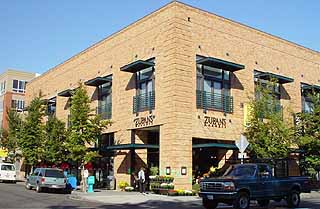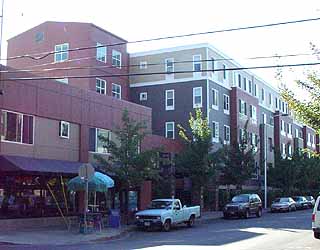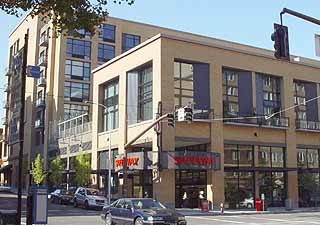
DJC.COM
October 7, 2004
Mixed feelings about mixed-use
Lane Powell Spears Lubersky

Photos courtesy Lane Powell Spears Lubersky
One of Portland’s successful redevelopments is Belmont Dairy. Developers in 1996 took an abandoned building and turned it into apartments and 26,000 square feet of retail, including a Zupan’s Markets.
|
Portland has been lauded by many as a model for urban renewal and mixed-use development.
The Pearl District, Belmont Dairy, Rose Garden Arena, Museum Place, University District, North Macadam District and the Memorial Coliseum are only several of the many past and future redevelopment projects and neighborhoods that come to mind. Some projects have succeeded while others have struggled.
For those undertaking urban redevelopment projects, only one thing is certain: there is no clear-cut recipe for success.
Risky redevelopment
Urban redevelopment — especially mixed-use projects — is not for the faint of heart. Indeed, some developers avoid these projects altogether. So why go through all the brain overload and attempt a project that is likely to fail? In order to answer this question, we must first peel back the layers of the project onion to understand what's inside.
A typical mixed-use project often consists of ground floor retail with either housing or office space above. In some cases, such as the Rose Garden Arena or the Memorial Coliseum, many uses will be mixed together in one or more buildings at the project site.
Some mixed-use projects are not limited to uses within one building and may include entire neighborhoods where different uses are mixed together in close proximity. Many planners see mixed-use projects that have a housing component as an important factor in reviving decaying urban and industrial areas.

Belmont Dairy has 66 apartments and 19 residential lofts.
|
Mixed-use sometimes gets confused with development objectives such as increasing density, reducing the number of vehicles, creating localized employment, gentrification of urban neighborhoods, and providing dynamic living environments. In this sense, mixed-use is often associated with terms like "smart growth," "new urbanism," "transportation-oriented development" and "traditional neighborhood development." Keep in mind, however, that mixed-use is merely one possible component found in these development concepts.
Development challenges
Most local municipalities and agencies are now encouraging mixed-use redevelopment.
Because of increased costs of this type of development, government agencies' involvement is necessary and their participation is often quite helpful. For example, incentives from Metro's transit oriented development program, and various partnership arrangements with the city of Portland or the Portland Development Commission, can allow development of mixed-use projects that otherwise wouldn't get done because of concerns about unfavorable economic returns.
For affordable housing components of mixed-use, subsidies can help the financial returns for the developer and make a project more economically viable. Some developers shy away from mixed-use because of the unpredictable economic return, especially if governmental support and subsidies are uncertain or too expensive or time consuming to obtain. In short, mixed-used development often requires long-term perspective, especially when trying to do it on a large scale.
If governmental financial incentives are not available, sometimes government agencies may include nonmonetary incentives to encourage mixed-use, such as an increase of the floor area ratio in the downtown zone for including a residential element, or permitting neighborhood zones that make it a lot easier to build commercial and office services in the neighborhood.
Another challenge in mixed-use developments involves market economics, which may govern the predominant use for the project, such as office or multi-family. Some retail use at the ground floor is often successful, especially when the demand is high. One rule of thumb is that when it costs more to buy land than it costs to add vertical improvements, then you build up.
Preliminary questions
So what are some key questions to ask before the project gets under way?
Consider the following:
- What is the highest and best use for the property being considered for redevelopment?
- How does it function in the context of everything around the property?
- How can the redevelopment respond to changes in the neighborhood?
- What needs in the neighborhood and region are currently unfulfilled?
- What are the long-term prospects for the area?
- What are the property owner's needs and objectives, and how can the project meet or exceed those needs and objectives?
- What are the financial objectives (i.e., long-term income stream, income tax credits, or short-term profit maximization)?
- How can the project achieve the highest returns with the least risk?
- What are the financing constraints and objectives?
- What are the critical paths and timelines to getting the project done on budget and on time?
There are, of course, numerous other questions that will need to be answered and issues to resolve as the framework for the redevelopment gets under way. Constant tension will surface as competing priorities become apparent, and as the parties attempt to answer these questions and resolve pressing issues.
Competing priorities
Portland's experience with mixed-use development shows that success is often determined through balancing various priorities, be they legal, political, economic, or social. By way of example:
- Sometimes a new city zoning ordinance that allows mixed residential and commercial uses can trigger unintended consequences. For example, the high-density development touted by city planners and transit types may sound like an excuse to build poorly constructed apartments to skeptical citizens. The mixed-use development concept often resonates best in run-down neighborhoods where the community is eager to see change.
- The city often has to walk a fine line between encouraging mixed-use development and saving the city's core industries. Usually, financial incentives such as tax breaks and bond financing are required to jump-start mixed-use development projects. In some instances, businesses are concerned that mixed-use development will actually reduce property values, although most critics say that is unfounded.
- Residents of newly built apartments often complain about the activities of nearby businesses, which were probably established in the neighborhood long before the residents moved in. For example, noise complaints are on the rise from nearby businesses and residents who live in the Pearl District because of trucks going to and from the post office.
- The changing dynamics of mixed-use projects often displace some businesses whose rents become unaffordable as the property values skyrocket. Some find that their businesses no longer match the residential complexion of the neighborhood.
- On the other hand, some new property owners, developers and businesses often successfully move in to cater to residents of mixed-use neighborhoods. In addition, bringing residences into business districts frequently means more money is circulating through the neighborhoods, and more people are around who are sensitive to reducing crime and increasing activities at street-level in an area that might otherwise become blighted.

Museum Place Lofts & Townhouses were finished last year in Portland’s Cultural District. The development has 140 apartments atop and behind a Safeway grocery store.
|
As you can see from the above sampling of competing priorities, any number of challenges confront the developer and planner proposing mixed-use projects, including added complexity because of the multiple uses, restrictive zoning codes, increased construction costs, difficult-to-obtain financing, wary equity investors, and a lack of suitable locations. Market readiness for unique and tough-to-locate projects is another real concern for the developer.
To illustrate these challenges, take a look at one redevelopment project currently being considered by the Portland City Council — the Memorial Coliseum. Last year a group of community-spirited businesses, along with neighborhood leaders, sports enthusiasts and a forward-looking developer, got together and developed a proposal to convert the coliseum into the Memorial Athletic and Recreation Complex.
One of the greatest challenges for the coliseum project is to meld successfully the objectives of a very diverse group of stakeholders, including the veterans, residents, neighborhood and community organizations, and businesses. All of these objectives must be intertwined with the overall objective of having a landmark building provide endless years of service to the community.
A project like the Memorial Coliseum, estimated to cost nearly $100 million to redevelop, will likely require financing from multiple sources, including both public and private money. That fact alone would give mixed feelings to any developer or planner. But think of the outcome — a new regional facility at the centerpiece of inner eastside Portland, which would include such things as an aquatic center, a skating rink, a series of gymnasiums, public recreational facilities, community service areas, and other sports-related health and educational services.
With the right group of partners, focused positive energy, and lots of creativity, this landmark project would likely keep Portland at the forefront of being known for innovative redevelopment projects for years to come.
Bryan E. Powell is partner and co-chair of the Real Estate and Land Use group at Lane Powell Spears Lubersky. His practice focuses on commercial and industrial mixed-use development, affordable and multifamily housing, leasing, acquisitions, sales, property management, and private/public redevelopment projects.
Other Stories:
- Tough Seattle neighborhood reinvents itself
- Here's how to get out of your car
- Let's learn about 'smart growth' — quickly
- SEED plants a legacy in Rainier Valley
- Workers get homes, with help from their bosses
- Living in a cubby hole? Make it look big
- Transportation overhaul for South Lake Union
- Office space: Are we finally shrinking?
- Downtown housing has a bright future in Seattle
- A road map for cities in transition
- The three C's of urban infill
- Where's the family in multifamily?
- Creative builders take on changing land rules
- Is Seattle ready for urban greensheds?
Copyright ©2009 Seattle Daily Journal and DJC.COM.
Comments? Questions? Contact us.